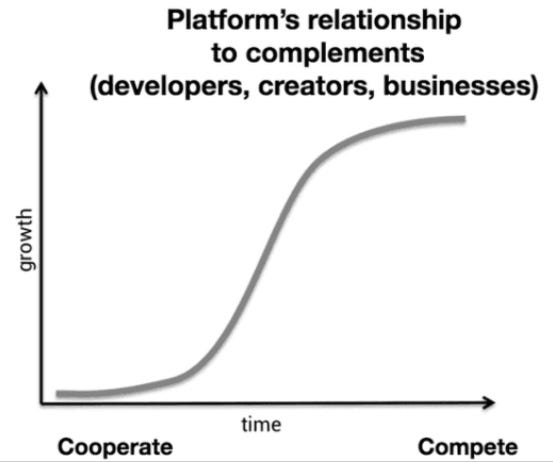Turning Networks Into Economies
Mental Model #4 - In Web3, Community = Marketplace = Economy · 3 min read
Welcome to Super Simple — the best way to go down the Web3 rabbit hole.
Short summaries of curated content. No external links. No biases. < 5 mins. Free
This post is also part 5 of a series summarizing the Bankless Podcast with Chris Dixon. Scroll to the end to learn more or start from the beginning here
Turning Networks Into Economies
The Internet is a network of networks.
We have built millions of networks over 20 years. Facebook, Twitter, YouTube are examples of large networks. Each Facebook group, Twitter following or Youtube channel is a smaller network.
The main business model we have managed to layer on top of these networks is advertising.
There were attempts at other models. Payments and commerce was initially built on top of these platforms by third parties. But the Web2 platforms put their own financial interest ahead of the network participants. They showed resistance. Support for third party apps were often removed without warning, ruining businesses. Facebook and Twitter were famous examples of this.

S-curve: The platform needs its builders to grow initially but ends up competing with them later on. Or price gouging and demanding very high take rates.
When the Web2 platforms themselves get around to attempting non-ad monetization, such as YouTube encouraging direct donations, take rates are extremely high on account of user lock-in.
Sometimes, creators leverage their followings to try and sell things off-platform. Or try direct monetization on 3rd party platforms like Patreon.
But its not a native experience. There is friction, like entering a credit card each time. Its not a closed loop from browsing to buying. Hence, conversion rates are very low.
This is what Marc Andreessen, creator of the first widely used web browser Mosaic, calls “the original sin of the internet” — payments not being incorporated in to the browser itself.
This is also why the internet as an industry settled on advertising. The ad auction, targeting and money flow are all a digital closed loop.
With tokens, we now have a way to let value flow through networks freely. They turn information networks into marketplaces i.e. into economies.
Through Tokens, Community = Economy
Communities can now be centered around the token.
For instance, lets say a band has built a decent following on Instagram and Facebook but only gets pennies from streaming services. Using tokens and NFTs, the band can upgrade their communities into an economy.
Let’s first consider the definition of a market-based economy - they allow goods to flow freely, according to supply and demand1. The producers own what they make and decide their own prices, while consumers own what they buy and decide how much they’re willing to pay.
Tokens enable exactly this!
Coming back to the example of the band, the goods that flow through their economy might be social tokens, digital art, collectibles, tickets, game objects, digital access, exclusive experiences, or something we haven’t thought up yet. Its still early days.
The band monetizes when they issue these tokens but since tokens are programmable, just a line or two of code can also get them a cut of every token resale. Or some other financial model we haven’t thought up yet. Its even earlier days on that front.
Consumers now own the tokens (goods) they buy and can trade with each other in the economy.
Importantly, the tokens are portable. And they are platform-neutral. This token-supported economy can flow through Twitter, Discord, Telegram, Instagram, seamlessly.
The band is incentivized along with the community to make this economy as large as possible. This gives the community extra motivation to evangelize the band.
Also, the tokens are composable. If you have a good idea, you are welcome to contribute or build on top. In our band example, a community member would be free to build say, a game with features that requires the band’s tokens to get access to.
Said differently -
Web3 Economies Are Cities, Not Theme Parks
The internet of today feels like a theme park. You enter an ecosystem owned by a big corp. All the places you visit and restaurants you eat at are also owned or leased by that big corp. This is not good. After all, unlike the diverse restaurants in your city, you don’t expect the food at DisneyWorld to be that good.
Instead, Web3 ecosystems feel like cities. The open protocol infrastructure is akin to a city’s sidewalks being immutably public, so builders (entrepreneurs, creators, developers) are not worried about suddenly being charged a toll.
Thus, these networks grow organically, bottom-up, collaboratively.
A single company or a theme park can never compete with that creativity. Web3 communities are decentralized bazaars with free trade, not a centralized department store.
Just one more mental model to go. Its an important one as it dispels the most common pushback of Web3 —
(Mental Model #5 - Disruptive technologies often arrive with flaws: toy-like, expensive, janky, lacking clear applications)
If you stumbled on to this post, start with part 1 - It Is Impossible Not To Be Excited By Web 3 (After Reading This)
Was This Helpful?
This quick check-in would be very valuable and a few seconds.
Did the summary make you more likely to watch the episode?
1. More Likely
2. Less Likely
4. Was Never Going To Watch The Whole Episode
5. Was Going To Watch The Whole Episode Anyway
Click on the appropriate option, and you can even see what other’s have voted
Appendix
My Two Cents
I still have nothing to add here.
Source
The Bankless Podcast Featuring Chris Dixon Interviewers - Ryan Sean Adams and David Hoffman, The Bankless Podcast Guest - Chris Dixon, General Partner at a16z
Additional Sources and Readings
Twitter Thread by Chris Dixon -
Footnotes
Source: Investopedia




